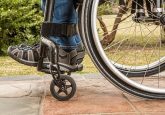Author Archives: Brett F
-
Compare Wheelchairs: Electric vs. Manual
Today, with advancing technology and even more advanced medical needs, the market for wheelchairs is booming. There is a multitude of wheelchairs; however, they all fall under two general categories; electric and manual. An electric wheelchair is operated by a power source that is controlled by the user. A manual wheelchair is self-propelled and does not operate with the assistance of a battery. Both types of wheelchairs offer similar support, comfort, and mobility. However, based on the needs of the wheelchair user, it is likely that one style is a better option. In this article, we’ll compare wheelchairs and their unique features. Keep reading to determine which model is best for you! Consider Unique Needs What will you be using the wheelchair for? Having a clear idea when, where, and how often you will be using the wheelchair will help you decide which one is best for your unique needs. A good place to start is to compile a list of the non-negotiable features you need in your wheelchair. Moreover, make a note of additional features that you would like to have. To get the wheels turning, consider the following questions: Do you need a lightweight wheelchair that can fold down for easy transportation?Does the user need to move around without assistance?Will the patient spend long periods of time in the wheelchair?Will the wheelchair be regularly going over different types of terrain? Doing this will keep you from being overwhelmed by the large selection of available wheelchairs. It will also give you a framework to compare wheelchairs and shop with confidence. Now that you have an idea of what you are looking for in a wheelchair, let’s consider the pros and cons of using a manual vs. electric wheelchair. Compare Wheelchairs: Electric and Manual Manual Wheelchair: Pros and Cons A manual wheelchair is one that requires physical effort to move. These chairs have large wheels that allow the user to propel the chair forward. They also include handles at the back so the user can be pushed. Manual wheelchairs come in many different styles. For example, lightweight wheelchairs can fold down to fit in compact spaces, and transport wheelchairs are ideal for travel. Pros They are easy to travel with. This factor is important for users who will be out and about often. Manual wheelchairs can easily fold down for storage. Many manual wheelchairs are lightweight and can be lifted and moved around with little effort. For instance, the Drive Medical Blue Streak Manual Wheelchair fits easily into the trunk of a car. It is low maintenance as compared to other chairs. Manual wheelchairs have fewer moving parts than electric chairs. They don’t come with cords or a joystick that needs to be replaced at regular intervals. Keep in mind that manual chairs still require upkeep to maintain the comfort and safety of the user. However, the maintenance is significantly less than that of an electric chair. There is no need to charge or maintain batteries. Because a user or caretaker powers them, manual wheelchairs are ready to go at a moment’s notice. They do not have batteries or charging stations. This can mean less hassle for the user and confidence, knowing their chair is ready to go. Cons User is likely to exhaust or exert themselves without proper conditioning. Manual chairs require the user to have some upper body strength to move forward on their own. Even for someone in good physical condition, pushing the chair around can grow tiring. If the user is elderly or has physical limitations, you may want to choose an electric wheelchair. Otherwise, the wheelchair user will need a companion to push him/her around. If an individual with physical limitations pushes the wheelchair, it could lead to an upper-body injury. Before coming to a decision, keep reading our wheelchair comparison guide to figure out which suits your needs. Electric Wheelchair Pros and Cons An electric wheelchair also referred to as a power chair, is powered via a battery and offers the user an easy way to get around. There are many benefits to choosing an electric wheelchair. Consider the pros and cons below to see if it’s right for you! Pros They are suitable for different types of terrain. A great advantage of an electric wheelchair is the ability to travel over bumpy roads and other difficult terrains. With sturdy wheels and a reliable power source, electric wheelchairs can navigate outdoor environments well. While some electric wheelchairs specify that they are ideal for indoor use, others are suitable for both indoor and outdoor activities. The ActiveCare Renegade Wheelchair, for example, is practical for outdoor use. It takes little effort to operate. Perhaps the largest advantage of an electric wheelchair is the ease of use it offers users. Electric wheelchairs are controlled via a joystick that is positioned at the top of the armrest. By steering the joystick, the user can get around without expending a great deal of effort. If the user of the chair does not have the physical strength to self propel a manual chair, an electric wheelchair may be a better option. It can navigate tight spaces. With increasingly technical structures, electric wheelchairs offer an outstanding turning radius, meaning they are great for tight spaces. These chairs make indoor use around corners and narrow hallways a simple task. This is an advantage over a manual wheelchair, which typically has a wider turning radius. Cons They are not ideal for travel. Electric wheelchairs are heavier and not as compact as manual wheelchairs. As a result, they pose a challenge when it comes to travel. Because these chairs are bulkier than manual wheelchairs, lifting and moving them takes much more effort. Additionally, you may need a large car to transport this style of chair. They have more maintenance costs. From the battery to the charger to the joystick, there are many important parts that make up an electric wheelchair that requires upkeep. If your wheelchair requires maintenance, it may cost you more money over time. Compare Wheelchairs then Buy From a Trusted Provider With the pros and cons of manual and electric wheelchairs in mind, it is time to search for your ideal wheelchair. Avoid stress, bad customer service, and paying too much by shopping at a top-ranked medical service equipment provider. Amica Medical Supply is the largest online Authorized Dealer for the top brands in the industry. Amica ensures that you get the lowest price and offer exceptional customer service. Have a hassle-free experience by wheelchair shopping at Amica Medical Supply! Fill out a contact form for more information today -
How to Buy a Wheelchair
When shopping for a wheelchair, there are many factors to consider before purchasing. The right wheelchair will provide comfort, mobility, and safety for the user. But not all wheelchairs are created equal. Luckily, we’ve compiled a guide on how to buy a wheelchair so that you can shop with confidence. Keep reading for a breakdown of things to consider when shopping for a wheelchair along with recommendations on the best wheelchairs. Choosing the Right Wheelchair First and foremost, consider the unique needs of the wheelchair user. Is this wheelchair going to be used for extended periods or just short trips? Will the wheelchair user be self-propelling, or do they require someone to push the chair? Listing the qualities, you are looking for in a wheelchair will streamline the search prosses. Additionally, it will narrow down the options and provide clarity on what to look for. Explore some different types of wheelchairs and the features they offer below. 1. Standard Wheelchair Standard wheelchairs come with large, sturdy wheels so the user can propel them. Additionally, handles on the back offer the option for the user to be pushed in the wheelchair. These chairs are built with a sturdy frame made of steel, meaning they are durable and long-lasting. Standard wheelchairs can be folded to increase portability and are generally cost effective transport solutions. Typical Weight: 35-44 lbs Ideal For: Those who won’t be in the wheelchair long term. It can be used for excursions and daily use to get around. Our Pick: An easy to maneuver, durable standard wheelchair: The Rebel by Drive Medical 2. Transport Wheelchair As the name suggests, transport wheelchairs are made to be portable. They come with a collapsible frame, making them easier to pack up than standard wheelchairs. Transport wheelchairs have four small wheels and must be pushed by someone. Despite being lightweight, some transport chairs can support up to 300lbs. Typical Weight: 20-30lbs Ideal For: Short trips out and about or daily use for short periods. Our Pick: Designed with comfort and portability in mind: The T-2700 Transport by Karman Healthcare 3. Lightweight Wheelchair Lightweight wheelchairs are a popular wheelchair choice for many reasons. Firstly, they are easy to use. They allow self-propulsion and are. Secondly, they are easily stored and can be transported with minimal effort. Lightweight wheelchairs also offer many adjustable parts. You can adjust the seat angle, foot and armrests, and more. Typical Weight: 25-34 lbs Ideal For: Frequent use. Individuals who can move around on their own and would like more independence would benefit from a lightweight wheelchair. Our Pick: A lightweight yet durable standard wheelchair: The Cruiser III by Drive Medical 4. Reclining Wheelchair Reclining wheelchairs offer a great amount of adjustability and comfort. They allow the user to recline at varying angles to relieve pressure. These chairs are typically larger than other wheelchair types, but there are lightweight versions available. Reclining wheelchairs make transferring users from the chair to the bed easier. This is due to the reclining back feature that can be adjusted to be parallel to a bed. Typical Weight: Varies. Lighter models feature a 35lb frame Ideal For: Those who will be using the wheelchair full time. Individuals with low blood pressure can benefit from the increased circulation provided by the angling of the chair. Our Pick: A versatile and reasonably priced recliner: 9000 XTR by Invacare 3. Bariatric Wheelchair Bariatric wheelchairs, or heavy-duty wheelchairs, can accommodate users up to 600lbs. They feature reinforced frames and wider seat widths. Depending on the model, some bariatric wheelchairs can support up to 850lbs. Some bariatric wheelchairs come in foldable models to allow for easier transport. Typical Weight: Around 50lbs Ideal For: Users who require additional weight support. Those who need a wider seat or have higher weight capacity requirements can benefit from a bariatric wheelchair. Our Pick: A durable chair with reinforced frames and upholstery: Sentra HD500 by Drive Medical Ensure a Safe Ride Once you know the type of wheelchair to look for, it’s time to choose the correct seat width. Choosing the correct wheelchair seat width is pivotal in ensuring a safe and comfortable ride for the user. The size of a wheelchair’s seat impacts the overall wheelchair size. Thus, choosing the seat width is the main step in determining wheelchair size. The typical seat width ranges from 16” to 20”, with 18” being the width for an average adult. For more information, check out our guide to understanding wheelchair width. Where to Buy a Wheelchair With so many medical suppliers and stores, the options may feel overwhelming. Simplify your shopping at Amica Medical Supply. Amica offers a price match guarantee on all wheelchairs as well as excellent customer service so your experience can run smoothly. With a large selection of wheelchairs and knowledgeable customer service reps, you are sure to find the wheelchair that suits you. If you still have questions, don’t hesitate to contact Amica Medical Supply today. Shop the wide selection of wheelchairs available at Amica Medical Supply today -
Guide to Best Special Needs Strollers For Kids
Are you searching for a safe, comfortable way to transport your special needs child? A stroller may be the solution! For one, special needs strollers easier to transport than wheelchairs, since they typically fold down. Additionally, they can handle rougher terrain than wheelchairs and do not require physical exertion and are easy to push. Special needs strollers can open up the world for children with special needs, making outings easier for their families. Read on to find the perfect stroller for your special needs child! Check Out These Top Strollers for Special Needs Children! 1. Special Tomato Jogger Stroller The brand Special Tomato exclusively creates medical equipment for children with special needs. As such, the Special Tomato Jogger Stroller was developed with special needs children and their families in mind. Designed to be portable and durable, this lightweight stroller is just 27 pounds. Moreover, the jogger stroller is an all-terrain model that is suitable for children with mild to moderate physical involvement. Weight limit: 110 lbs Key Features: Easy to fold frame 5 point harness for safe, secure transport Quick-release pneumatic tires Adjustable seat Swivel- front tire for maneuvering narrow areas indoorsRecline setting for naps 2. Special Tomato EIO Push Chair In terms of features included, this is a top stroller for a special needs child. The Special Tomato EIO Push Chair is built to grow with your child from infancy to elementary age. The padded hip and back inserts are removable, allowing for increased seat width as your child grows. Its large airless wheels make it easy to travel over bumpy terrain, ready for on the go activities. Furthermore, the stroller is built to form to your unique needs. If you need plenty of storage room, this stroller can help. Storage features include a wide basket underneath the stroller, water bottle holders on either side and a secure pocket in the canopy. Weight limit: 90 lbs Key Features: Adjustable seating pads for hip and back Recline angle setting for naps All-terrain wheels Spring suspension 5-point chest harness with adjustable straps Adjustable leg restDetachable canopy 3. Wenzelite Trotter Mobility Rehab Stroller This sleek, lightweight stroller provides safety and comfort for the rider. The Wenzelite Trotter Mobility Rehab Stroller offers an adjustable seat and back angles to supply optimum support. In fact, the five-point harness features padded straps to provide security and comfort. Moreover, this stroller has been crash-tested to ensure a safe ride and has a machine-washable fabric for easy cleaning. Weight limit: 250 lbs Key Features: Curb assist lever for curbside navigation Adjustable seat angleAdjustable back angleCrash tested 10” rear wheels with toggle lock Purchase The Perfect Special Needs Stroller Today! Selecting the right stroller for a special needs child can be hard. It requires research to find the perfect model that fits your requirements. After all, you want your child to be as comfortable and safe as possible! Luckily, Amica Medical Supply carries some of the best strollers for special needs children and offers a price match guarantee. Amica also provides access to knowledgeable product experts who can aid you in your purchasing decisions. With low prices all year round and unparalleled customer service, Amica Medical Supply is here to help! Have questions about special needs strollers? Don’t hesitate to contact us today! -
What Does an Alternating Pressure Mattress Do?
Do you or your patient spend long hours in bed? Laying in bed for long extended periods of time can cause skin ulcers and bedsores to form, which can be extremely uncomfortable for patients. The solution? An alternating pressure mattress! These mattresses work wonders for bedridden patients. Learn more about how alternating pressure mattresses work as well as the life-changing benefits of using one in this comprehensive article! What is an Alternating Pressure Mattress? How They Work Alternating pressure mattresses have pockets of air located length-wise down a mattress that inflates and deflates one at a time, alternating the pressure points on the body. These mattresses are specially made for patients who spend long hours in bed. What is the Standard Size? The standard size for an alternating pressure mattress is 75 x 32 inches, which fits standard-sized hospital beds. However, some bariatric models can reach up to 80 x 42 inches. Additional Features Some models can turn patients from a back-lying position to a side position by as much as forty degrees, allowing patients to shift in bed without exerting themselves. Additionally, some mattresses have areas at the top and bottom of the mattress that guard sensitive skin against unnecessary friction. Last but not least, some alternating pressure mattresses have safety features that prevent patients from getting trapped between the mattress and the bed rails. Benefits of Using an Alternating Pressure Mattress Treats and Prevents Bed Sores and Skin Ulcers One of the biggest benefits of using an alternating pressure mattress is that it reduces the risk of developing bed sores or skin ulcers. Essentially, because the mattress inflates and deflates at different intervals, the patient won’t have continuous pressure subjected to any one area on his/her body. In other words, alternating where pressure is placed on a patient will ultimately reduce the risk of bedsores and skin ulcers. Additionally, the mattress can help treat people who already have pressure ulcers. Patients will overall feel more comfortable while in bed. Increases Circulation Second, these mattresses enhance circulation through pressure redistribution. When the air pockets in the mattress deflate, the change in pressure causes increased blood flow. This way, the blood can travel to the skin and other tissues to heal skin breakdown, heal bedsores, and nourish the skin. Overall, increased circulation will increase the health of someone who spends long hours in bed or cannot move. Enhances Sleep Last but not least, the mattresses reduce the need for tossing and turning, allowing patients to wake up more awake and refreshed. When you shift in your sleep, it’s usually to reposition where your mattress is pressing against you so you don’t develop bedsores. However, when individuals toss and turn, it can cause you to fall out of deep sleep or even wake up. An alternating pressure mattress thus makes it easier for patients to get the rest they deserve by reducing the need for moving in sleep. Purchase Your Alternative Pressure Mattress Today! In the end, alternating pressure mattresses are a must-have for anyone who spends long hours in bed and is at risk for developing bedsores or skin ulcers. But where can you find top-quality mattresses at the lowest prices available? Amica Medical Supply is the largest online dealer and distributor of top brand medical products. Their close relationship with manufacturers allows Amica to offer the lowest prices possible on all their products. Additionally, when you buy an alternating pressure mattress, you get free shipping. With excellent customer service and safe, secure ordering, Amica is a go-to for all your medical supply needs. Shop for alternating pressure mattresses today! Their large selection makes it easy to find the perfect one for your needs and at the right price. In the market for a hospital bed to go with your alternating pressure mattress? Amica has many to choose from, whether you want to rent or buy one. For more information, contact Amica Medical Supply today










